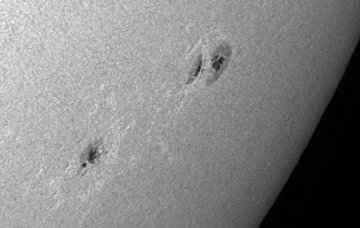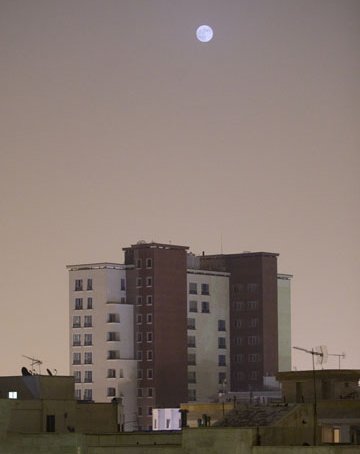| GRAND CENTRAL SPACE STATION: On July 11th, space shuttle Endeavour will blast off from the Kennedy Space Center on a mission to the International Space Station (ISS). On July 12th, a Russian supply ship (Progress 33) will approach the ISS for docking tests. On July 13th, Endeavour itself will rendezvous with the ISS. Stay tuned to the Simple Satellite Tracker for a busy series of flybys. GOOD-BYE SUNSPOT 1024: The biggest, most active sunspot in two years is about to disappear. Sunspot 1024 is approaching the sun's western limb and, later today, it will go around the bend. Pavol Rapavy sends this photo from Rimavska Sobota, Slovakia: 
Readers with solar telescopes should train their optics on the edge of the sun. Even minor eruptions from sunspot 1024 could hurl photogenic blobs of hot plasma high over the limb where they would shine in beautiful relief against the black of space beyond. The parting shots could be the best of all. more images: from Cai-Uso Wohler of Bispingen, Germany; from David B.V. Tyler of Buckinghamshire UK; from D. Booth, T. Emerson, J .Stetson of South Portland, Maine; from Andy Yeung of Hong Kong; from Stephen Yeathermon of Santa Fe, Texas; BLUE MOON OVER IRAN: A severe dust storm so large that it is visible from space is blowing across Iran. Government officials have closed schools, cancelled flights, and warned the elderly and children to stay indoors. The only good thing about the storm is that it is turning the Moon a pleasing shade of blue: 
Amir H. Abolfath took the picture from Tehran on July 7th. "I thought blue moons were a myth," he says, "but there it was." Yes, blue moons are real. They appear when the air is filled with fine particles of dust (or other aerosols) about 1 micron in diameter. This is just the right size to make dusty air act as a blue color filter. Because the dust storm is so large, blue moons could be a regular fixture in the Persian sky for some nights to come. more images: from Farzad Zamanfar of Tehran, Iran;
2009 Sarychev Sunset Gallery
[See also: 2008 Kasatochi Sunset Photo Gallery]
2009 Noctilucent Photo Gallery
[previous years: 2008, 2007, 2006, 2005, 2004, 2003]
Explore the Sunspot Cycle | 
